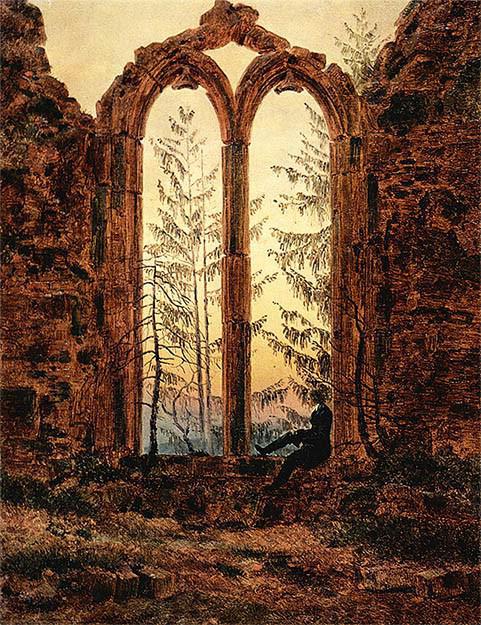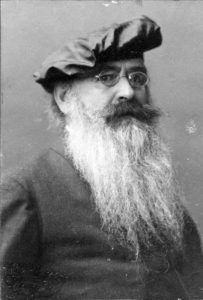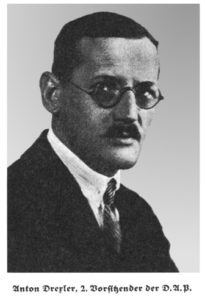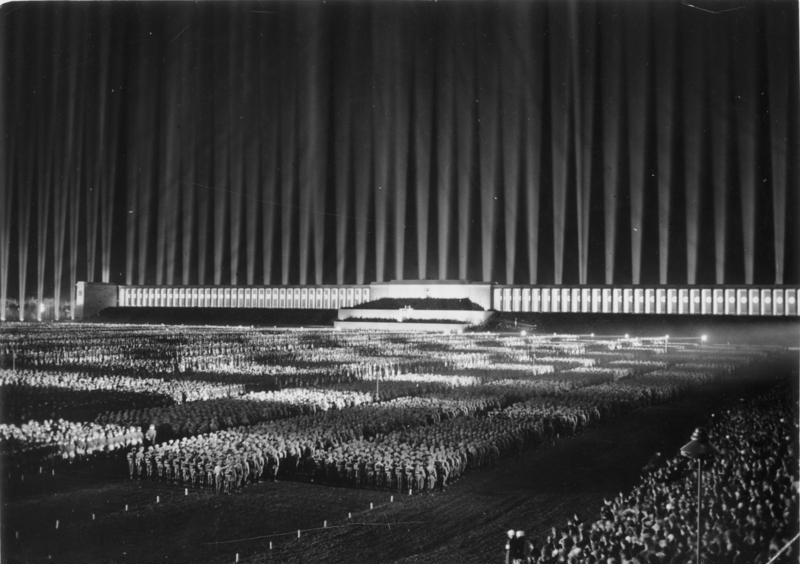The mystical and political internal contradictions of Germany were bound to call an “external” counterbalance into existence — the necessity to obey the law-defined order. First it was imposed by the government, later it became “second nature”.
Editor’s note: Strong German capitalism, “crowd theory”, elite organizations were all a factor in giving birth to Nazism. But why was Hitler supported so much? Why did the ideas of Nazism were accepted in the first place? Because much was boiling in Europe and Germany in particular at that time, just like much is boiling in Europe today. Hitler was not the first spawn of that boiling “soup”, but he “stood on the shoulders of giants”. The first terrorist army in world, ISIS, isn’t the first terrorist organization in the Near East, but it stood on the shoulders of giants. The real XXI century fascism in Europe did not rise yet, but the giants are already here. The mutated capitalism which is destroying nation states for the sake of a single global state is here. Bandera Nazi Kiev junta in Ukraine, the first fascist government in modern-day Europe, is here (the following articles deal with Bandera Nazism in detail). And there is no doubt that Hitler, Bandera and other Nazis will be cleared of all charges after communism will be condemned. Because if communism is the absolute evil, then someone who fought it becomes a hero.
The “soil” on which German Nazism blossomed was very different from that of Italy. Both the supporters and, especially, enemies of Nazism wrote extensively on this.
Communist authors put a strong emphasis on the especially strong, organized German capitalism that understood its own interests very well (something both Marx and Lenin wrote about, and what is admitted by all researchers). They think that Nazism was “constructed” by major German capitalists to realize the plans of imperialist expansion. This position (reputable up to this day) was articulated by Comintern in 1936.
Other influential authors, such as Hannah Arendt, seek the origins of Nazism in Le Bon’s and Jose Ortega y Gasset’s “crowd theory”. Some liberal authors think that the answer is in the “totalitarian” and “aggressive” particularities of the outlook of German people, due to which, supposedly, almost all of the German people accepted Nazism and became a tool in the hands of the “mad Fuhrer”,
There is some truth to these statements, but, in our view, they are far from explaining everything. Which is why I will take the risk to add to and specify some points.
I want to note that Germany was strongly, at all social levels, “infected” by all kinds of mysticism at the turn of the 20th century.
It was the mysticism of chiliastic sects that dreamed of creating the Kingdom of God on Earth by very different means: from secluded collective “life according to God” in the community of adepts to revolutionary destruction of the “sinful” reality. The memory of the deeds and horrors of chiliastic peasant uprisings and urban revolts of late Middle Ages and early Modern era was quite alive among both the folk and the elites.
It was philosophic mysticism. It is no coincidence that it is the German “romantic” philosophy of XVIII–XIX centuries (specifically, Friedrich Schlegel, Friedrich Schleiermacher, Johann Hölderlin) gave birth to the very influential movement in art (particularly in literature and music), which was called “German Romanticism”. And which was deeply soaked with mystical motives — from Hoffmann to Heine and from Schubert to Wagner.

It was, lastly, the esoteric Gnostic mysticism with its flaming radical denial of the goodness of the World created by God and with its division of humanity, created by this non-good god, to “humans” and “non-humans”. In this sense, the clear Gnostic themes of Goethe’s “Faust” (for example, the theme of “The Mothers”), which Sergey Kurginyan mentions in his work “The Fate of Humanism in the XXI Century”, are no coincidence. These themes very distinctly manifest themselves in Mephistopheles’ remark: “…everything created, In turn deserves to be annihilated: Better if nothing came to be.”
This widespread (“folk” and “elite”) worldview mysticism, and very diverse mysticism indeed, was complemented by the historical distinctions of the centuries-long fragmentation of Germany. It was unified by Bismarck (and not without a conflict!) only in the second half of the XIX century.
The mystical and political internal contradictions of Germany were bound to call an “external” counterbalance into existence — the necessity to obey the law-defined order. First it was imposed by the government, later it became “second nature”. It seems that the German “Ordnung” — seeking of order and the willingness to abide by it (acknowledged by all serious researchers as a trait common to Germans) — became that “other side” of the character of the German people which was supposed to compensate for the boiling and contradictory mystical side of this character.
But, at the same time, as many scientific and popular publications about Nazism tell us, mysticism didn’t go anywhere.
It, among other things, was constantly felt in literature and art, in everyday mythology, as well as in “half-spontaneously” created peasant and urban communities (so called “vereins”) — from clubs for studying folk legends and myths to choral associations of singers, from theater ensembles to organizing festivals in honor of some significant local historical event.
However, this grassroots “semi-spontaneity” soon drew the attention of organizers. The “Pan-German League” created in 1890-1891 became one of the first of such “collective organizers”. It started to merge the widespread mystical collectivism of vereins with political radicalism, militarism and military expansionism. The founders of the Pan-German League, Alfred Hugenberg (radical nationalist, politician, businessman), Friedrich Ratzel (one of the founders of geopolitics and antropogeorgaphy), Emil Kirdorf (the largest coal industrialist, extreme nationalist and a supporter of military “territorial expansion” of Germany), defined the goals of the League as “revival of the patriotic German consciousness“, “contribution to the energetic German politics” and “support of German interests abroad” (first and foremost, in Austria-Hungary with its large German and German-speaking population).
The Pan-German League launched its largest propaganda activity in support of the accelerated militarization of Germany (building of a powerful military fleet, rearmament and reorganization of the army, etc.), as well as the struggle against the national minorities (against Jews in Germany and in the world as a whole, French in Alsace-Lorraine, Poles in Silesia and West Prussia). In particular, the ideas of the theorists of racism and “Aryan chosenness of Germans”, as well as the ideas of geopolitics and the need to expand the German “Lebensraum” at the expense of the “racially inferior neighbors”, gained widespread currency in Germany thanks in large part to the activity of the Pan-German League.
Let us emphasize that vereins became the basis of a very widespread and quite organized cultural movement, “Völkische” (“folk”) in the end of the 19th and the beginning of the 20th century — again, thanks in large part to the activity of the Pan-German League. The organizers of “Völkische” placed the individual human soul in the core of its worldview — quite in the spirit of the mysticism of German romanticism. This individual human soul, supposedly, is the incarnation of distinct qualities of a certain people that grew up on a certain historical, geographical and cultural “soil” and has a reflection in the blood, in which the soul and the body of the individual coexist.

During the initial stage of its development the movement largely learned, “digested” and adopted racism, antisemitism and German “Aryanism” of Joseph Gobineau and Houston Chamberlain, and was being formed as strongly anti-Judaic and anti-Catholic. A line from the poem of Georg von Schönerer, “Without Judas, without Rome we build the cathedral of Germany“, became the primary motto of “Völkische” in the 20th century. Later such people as Guido von List (researcher of Scandinavian runes, the author of the myth that the Germans originated in the ancient continent of Arctogaia with its capital, Thule; he was one of the founders of the mystical-esoteric “Thule Society”) and Jörg Lanz von Liebenfels (esoteric Gnostic and the founder of the “Order of the News Templars”) took up the task of “guiding” “Völkische”.
First, they (without denying the most important mystical meaning of German blood and German soil) shifted the emphasis of German distinctiveness from “soul” to the militant and heroic “German Aryan spirit”.
Secondly, under their ideological and political guidance “völkisch” vereins achieved quite strict inner discipline, continually moved from the initial Lutheranism to supposedly “original” ancient German paganism, as well as added sport and combat training to their activity. And became enthusiastic about the goals of achieving dominance first in Germany, then in the world.
“Völkisch” vereins played a big part in mobilizing the German masses during World War I and were far from dissolving after Germany lost the war. By the time the Weimar Republic was established, approximately 200.000 people were members of “German Nationalist Protection and Defiance Federation”, the largest “völkisch” organization.
At the same time, according to many researchers, “Völkische”, as a mass people’s mystical-esoteric organization struggling for the “expansion of German spirit”, was more and more (subtly) controlled by non-transparent elite order-type organizations. It were these organizations that created that conceptual and ideological content which, together with the official activity of the Pan-German League, controlled the behavior of “völkisch” masses.
In 1912, shortly before the outbreak of the war, Guido von List, Hermann Pohl and Theodor Fritsch created the mystical-esoteric “Germanenorden”. Its key conceptual principles were anti-Christianity, Gnostic racism and antisemitism. Other key conceptual principles were the goals of realization of world domination of the ancient Aryan master race, which, supposedly, at this moment in history is most fully embodied in Germans.
Baron Rudolf von Sebottendorff, a researcher of Masonry and esoteric Islamic Sufism, joined the Germanenorden in 1913 and soon was granted the title of “Ordenmeister” (the head of a regional group of the order) in Bavaria. In 1918 Sebottendorff had established, with support of Guido von List the new “subsidiary” order — “Thule Society”. This occult-mystical organization, just like the Germanenordern, guided politically not only “Völkische”, but other German nationalist groups as well. “Völkisch” vereins and the Pan-German League acted among peasants and petty bourgeoisie; Thule Society, in addition, acted among the proletarian masses.

The German Workers’ Party (Deutsche Arbeiterpartei, DAP) was created in 1918 (it is claimed that it was created by the members of Thule Society). Adolf Hitler joined the DAP in 1919.
There is too much literature on Hitler’s life. Even a concise summary of this literature would lead to a significant digression away from our topic. Nevertheless, it is impossible to understand the rise of the key person in Nazism without certain biographical facts.
Adolf Hitler was born on April 20, 1889, in Ranshofen village in Austria, near the German-Austrian border, in the family of a civil servant, Alois Hitler. His father had to move from town to town due to his occupation. Due to this Adolf Hitler had studied in many different schools, which was one of the reasons why he had poor grades. He liked history, geography and, in particular, painting. Experienced great shock after his father suddenly died in 1903.
In 1907 Hitler, not having finished secondary school, applied for an art school in Vienna, but was rejected. His mother died in the end of the same year. In 1908 19-year old Adolf moved to Vienna. He applied to Vienna’s Academy of Fine Arts, but failed the exam again. After which he made a living by selling his paintings. He also evaded the draft to the Austrian army. According to the testaments of his acquaintances at the time, “he didn’t want to serve in the same army with Czechs and Jews and fight for the state of Habsburgs”, but at the same time “was ready to give his life for the German Reich“.
As we can see, Hitler was already responsive to the propaganda of Pan-German League at the time. Besides, Hitler was getting interested in politics at that same time and engaged in self-education: read a lot of books, studied French and English languages.
In May 1913 Hitler moved from Vienna to Munich where he lived until the beginning of World War I and worked as a painter.
During the first day of war Hitler asked for and was granted the permission to serve in the Bavarian army. He was sent to the front-line in October. He fought throughout all of the war, achieved the rank of Gefreiter and was awarded several decorations, including Iron Cross, Second and First class, and the Military Merit Cross (3rd Class with Swords). He was poisoned by gas due to a explosion of a shell in October 1918. Soon, while he was in the hospital, he found out that Germany capitulated and the Kaiser was overthrown.
Hitler returned to Munich, to his regiment, in March 1919. In June he was sent to agitator courses. There he met Gottfried Feder (the future economic theorist of NSDAP). He impressed the head of Bavarian Reichswehr agitation department so much by his powerful antisemitic speech that he was appointed “education officer” of the Bavarian Command.

In September 1919 Hitler received the Command’s task to participate in the session of the German Workers’ Party, DAP, recently founded by the railway locksmith Anton Drexler (as we have noted earlier, with the support of Thule Society). During the discussion Hitler convincingly defeated his opponent, a supporter of restoring the independence of Bavaria and the restoration of Wittelsbach dynasty, from a Pan-German standpoint. Drexler immediately offered Hitler to join the party.
After consulting the military commanders, Hitler accepted this offer, discharged from the military and became a member of the DAP. But not an ordinary member. Hitler instantly demanded and received the position of chief of propaganda for the party.
Hitler organized the first large “public presentation” of DAP on February 24, 1920, and announced the party platform in his speech — the “25-point Programme,” composed by him together with Feder and Drexler. The Programme included the demand to abrogate the Treaty of Versailles, which acknowledged the responsibility of Germany for the war and obliged it to pay reparations to the winners, as well as points regarding Pan-Germanism and establishing a strong central government, demands for socialistic transformations in the economy and militant antisemitism. On the same day DAP was renamed at Hitler’s suggestion to National Socialist German Workers’ Party (Nationalsozialistische Deutsche Arbeiterpartei, NSDAP).
Drexler was deposed to a position of honorary president of the party in July 1921 after a conflict among the leaders of the party. Hitler was elected the Chair of NSDAP with almost unlimited authority. On this position he started his political career.
Source (for copy): https://eu.eot.su/?p=3332
This is the translation of the ninth article (first published in “Essence of Time” newspaper issue 62 on January 29th, 2014) by Yury Byaly of a series on essence, birth and rise of fascism. Part 1: Marxism, imperialism and the justification of inequality. Part 2. Part 3. Part 4. Part 5. Part 6. Part 7. Part 8.




